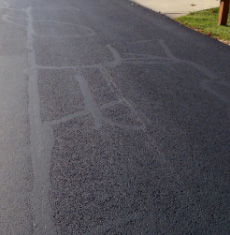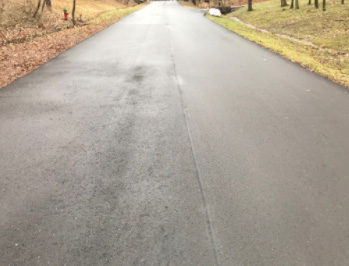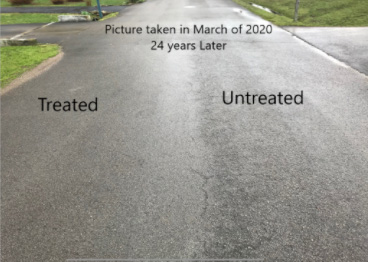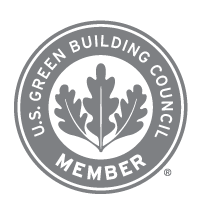Asphalt Surface Treatment vs. Genuine Rejuvenation
Category: Blog Articles By: Zack Helm
Over the past decade the concept of pavement preservation has seen a large increase in popularity. Road managers are finding that to effectively improve their network’s infrastructure, their tool box of roadway solutions must evolve. However, the resulting increase in treatment options has caused a bit of confusion, especially when comparing asphalt surface treatments vs. asphalt rejuvenation.
What’s the difference?
Buildipedia refers to asphalt surface treatments as the “reconditioning of the wearing (surface) course of older existing asphalt pavements.”1 Such treatments are topical and are typically used on older, structurally sound surfaces to prevent water intrusion and delay further pavement oxidation. You may see an increase in the use of surface treatments during election years, due to their aesthetic appeal to the public and their relatively low cost.
Below is a good example of a highly oxidized pavement that was recently crack sealed and then had an asphalt surface treatment placed. It is easy for a manufacturer to call an application like this a “rejuvenator,” but it is simply a protective coating for the asphalt. Surface treatments do nothing to improve the chemical composition of the asphalt binder within the pavement; they are, as the name implies, only “skin deep.”

In contrast, genuine asphalt rejuvenation is the process of restoring to the asphalt the actual chemical components that the high temperatures of production and subsequent oxidation have removed. These components, known as maltenes, are the sticky resin compounds in the binder that give the pavement its flexibility.
Both surface treatments and asphalt rejuvenation can be effective in addressing your pavement network; however, it is imperative to use them at the appropriate time in a pavement’s life cycle. When using a genuine rejuvenator with Maltene Replacement Technology (MRT), it is critical it be applied within the first three to five years of a pavement’s life. In fact, many agencies are noticing extremely beneficial results by placing the rejuvenator down the same year as the new asphalt. The cost of such rejuvenation adds only around eight to 10 percent to the original re-surfacing program budget, with studies demonstrating a resulting 30 to 40 percent increase in pavement life. Those of us who contribute to annual retirement plans would take those returns all day!
What You Can Expect
The photo below shows a newly paved sub-division, which was completed in 2019 in central Tennessee. A couple of weeks later, this community’s roads engineer specified a maltene-based asphalt rejuvenation product for the entire project. To help the agency determine the outcome, the applicator left untreated a 200-foot control section. Just six months later, the results were already evident. Notice the pitting and openings on the untreated (left) side, while the remaining treated (right) side is notably smoother with hardly any voids in the pavement.

The effects of MRT treatment remain visible far beyond a single year. Take a look at the below photo of an agency that used the same MRT rejuvenation product on the left side of the pavement in 1996, and then compare its surface 24 years later with that of the untreated (right) side.

Which one should I use?
My profession has allowed me the opportunity to work with asphalt surface treatments and rejuvenators. As stated, both should be implemented in a pavement preservation program; however, timing will greatly determine the success of your efforts. A maltene-based rejuvenator literally restores the asphalt to something close to its original chemical structure while imparting an in-depth seal to the pavement. MRT solutions should be placed within that three to five-year window before the pavement has become highly oxidized. Asphalt surface treatments, as protective coatings, are best used later in a pavement’s life cycle, once the asphalt has become more seriously oxidized with surface cracking apparent.
The Final Challenge
It is understandable why public works officials involved in infrastructure decisions are tempted to put something down on their roadways because it gives them a “pretty appearance.” I once had an official tell me “as long as residents have green grass and black roads,” complaints are minimal.
On the surface, this may seem true. But think about it: don’t most of your roadway complaints reference those nasty potholes we all are too accustomed to seeing? Doesn’t extending the service life of your roadways make more sense than investing in short-term, skin-deep improvements? As your pavements continue to age, there will likely come a time when surface treatments make sense; but if putting that time off for as long as possible is your goal, then genuine MRT rejuvenation is your solution.
The black shiny appearance of a roadway does not prove its durability. What road engineers need, and community members want, are sustained results – drive-worthy performance over time. MRT rejuvenators may not provide that like-new appearance that residents will notice; but it will provide them with roads that remain drivable longer and the assurance their tax dollars have been well spent.







